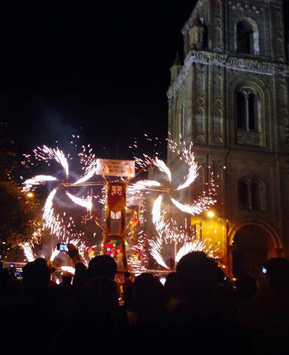Fireworks in Cuenca: A centuries-old tradition that lights up the night skies
By Jamil Moscoso
The first recorded use of pyrotechnics in Cuenca dates back to the early 1600’s, only decades after the city’s founding by Spanish conquistadors. In fact, explosives were first used in the city on May 28, 1614 to enliven the processions during the Roman Catholic Corpus Christi feast. It may have been the first ceremonial use of fireworks in Ecuador.

Fireworks over Parque Calderon.
The custom of animating religious celebrations with noisy, colorful pyrotechnics came with the Spanish colonizers who established Cuenca and hundreds of other and other settlements across Ecuador and the Americas. Since then, the fireworks tradition has become deeply rooted in Ecuador’s popular culture and remains a central part of both religious and non-religious festivities in the country.
According to a study of Cuenca’s cultural heritage by the Inter-American Center of Handicrafts and Popular Arts, (CIDAP), as of 2008, there were 50 operational firework workshops in and around Cuenca, mostly run by local families who produce their goods by hand.

A castillo is ignited.
Castillos, or castles, are one of the most popular pieces of handcrafted fireworks in Ecuador. Castillos are wooden towers, usually constructed of bamboo, rigged with fireworks that can reach 40 feet in height. Set off in public locations such as Cuenca’s Parque Calderon, their detonation during festivals is the highlight of most fireworks displays. During the Corpus Christi celebration, it is not unusual for four or five castillos to be ignited in a single evening. The fireworks on the castles, are designed to go off in sequence, beginning with small displays of sparks, showering down from, swirling pinwheels, concluding with a grand finale of loud explosions. rockets soaring into the night sky, and more sparks.
But the grandness of these handcrafted spectacles does not come without a price. The art of making and igniting pyrotechnics is a dangerous activity that requires a great deal of care, seriousness — and gunpowder. Over the years, there have been many accidents causing injuries to people and damage to property.

A 2012 fire at the San Luis seminary.
The most fireworks accident in modern times was the fire that destroyed much of San Luis Seminary, adjacent to Cuenca’s cathedral on Parque Calderon, in August 2012. Although the exact cause of the fire was never determined, it followed a fireworks show in which large amounts of fiery debris was observed falling onto the seminary.
Although the seminary has been rebuilt and is today open to the public, the fire destroyed roofs, historic statues and documents, as well as 200-year-old murals on a chapel wall.
The workshops where the pyrotechnics are assembled also pose a danger to artisans and surrounding property. In January 1, 2015, an unlicensed firework workshop in the El Tablon neighborhood in Miraflores was destroyed when fireworks ignited a blaze.
There is good news, however. Although buildings have been destroyed and many artisans and spectators have suffered fireworks-related injuries through the years, there are no recorded fatalities.
The seminary fire and accidents in workshops have prompted three municipal ordinances, in 2013, 2014, and another last month. The 2013 rules reduced the amount of gunpowder that could be used in fireworks and also required the presence of fire department personnel at fireworks shows.
In 2014, the municipal council passed guidelines for the manufacture of artisanal pyrotechnics and required stricter operating permits for the artisans.
In September, the council approved 28 rules intended to improve public safety. The new rules require set-back zones around all detonations, including castillos, during fireworks shows. They also mandate that no fireworks can be fired off between 1 a.m. and 6 a.m. The latest ordinance was supported by the Cuenca Guild of Pyrotechnics Artisans.
The city and artisans say, however, that the fireworks shows will continue, and that the colorful, noisy, and awe-inspiring 400-year-old tradition will remain part of Cuenca’s rich history.





















